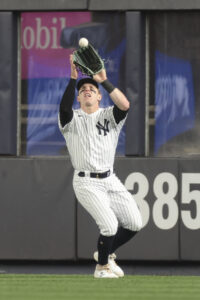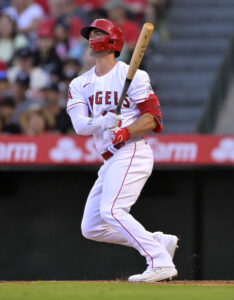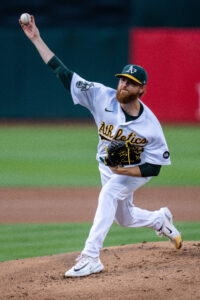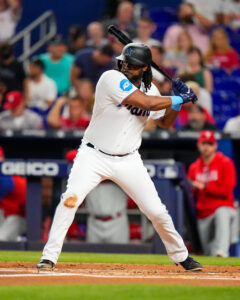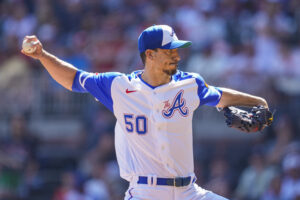A somewhat surprising trend began yesterday when the Angels placed six members of their active roster on outright waivers: Lucas Giolito, Hunter Renfroe, Reynaldo Lopez, Matt Moore, Randal Grichuk and Dominic Leone. The White Sox (Mike Clevinger), Mets (Carlos Carrasco) and Tigers (Jose Cisnero) all followed suit, to varying degrees.
In many ways, it hearkens back to the days of revocable August trade waivers, when it was common for teams to run the majority of their roster through trade waivers. That led to what was effectively a second trade deadline at the end of August, as high-priced veterans who’d gone unclaimed were free to be moved. This set of circumstances, however, is quite different.
The players waived by the Angels, White Sox, Mets and Tigers are on irrevocable outright waivers. Any team that is awarded a claim on one of these players immediately takes on the remainder of that player’s contract. If one of these veterans goes unclaimed — it’s likely that a few of them will — their current team does not have to outright them to a minor league affiliate. They can simply return said player to their active roster and continue playing him as normal. (The Angels reportedly already passed Tyler Anderson through outright waivers last week and just kept him on the roster after he went unclaimed.) Similarly, these players are quite obviously free to keep playing. Many of them played last night. Renfroe literally hit a home run as I was typing this paragraph. Waivers are fun!
The outright waiver period is 48 hours, meaning we’ll have resolution on everyone from this group at some point tomorrow afternoon (though news of the claims being awarded could be staggered a bit). Waiver priority is determined based on reverse order of winning percentage and is not league specific. League-specific waiver priority was unique to revocable August trade waivers and is now defunct. It’s a common misconception that it remains in place, but MLBTR has confirmed with league sources on multiple occasions that waiver priority is simply worst team through best team — in this case, starting with the A’s and ending with the Braves. More specifically, waiver priority is determined based on the reverse standings on the day players clear waivers, meaning we’ll know the final waiver priority for all of these veterans once tonight’s games are wrapped up.
That’s a whole bunch of preamble that may or may not have been necessary, depending on your prior understanding of waiver minutiae. It felt pertinent to do a brief crash course, however, given the unusual nature of this sequence of moves and the major ramifications it could hold with teams in a tight playoff race.
It’s fair to assume the non-contenders are going to pass on picking up any of these players — they’re all impending free agents — but any club with a glimmer of postseason hope could place a claim. That technically includes the Guardians and the Padres, although both are long shots, at best to play meaningful games in October. FanGraphs gives Cleveland and San Diego respective playoff odds of 3.3% and 1.8%, while Baseball Prospectus has the Guards at just 1.6% and the Friars at what seems like a generous 7%. You can never rule out the Padres on big-name players, but they’re already in the third tier of luxury penalization, so anyone they acquire will come with a 75% tax. It’d be a steep price to pay, but hey, when has that ever stopped president of baseball ops A.J. Preller and owner Peter Seidler?
We’re writing about the best fits for this trio of outfielders, however, and the “best” fit doesn’t seem like a team whose playoff hopes are the rough equivalent of hitting a one-outer on the river in a hand of Texas Hold ’Em. So, with all that said, let’s take a look at each outfielder, how much he’s still owed on his contract, his strengths/flaws, whether he’s likely to be claimed at all, and where he might best fit among the group of contenders who’ll have priority over the Braves, Orioles, Dodgers, Rays and Mariners (i.e. the upper echelon of MLB’s standings).
Harrison Bader
Age: 29 | Bats: R | Salary: $4.7MM ($783K yet to be paid out) | Position: Center Field
Bader is the youngest, the cheapest and the likeliest of this trio to be claimed. Age and salary play a major role in that, but so does his glove. Bader isn’t just the best defensive outfielder of this bunch — he’s one of the best defensive outfielders in Major League Baseball. He can play any of the three outfield spots, but the defense is so strong that it’s almost a waste to have him anywhere other than center. In 4243 innings of center field play at the big league level, Bader has piled up 43 Defensive Runs Saved and a mammoth 61 Outs Above Average.
For some further context, Bader’s 4243 innings in center field from 2017-23 rank just 96th among all big league players in terms of total innings played at one position. But he nevertheless ranks 18th among all Major Leaguers in Defensive Runs Saved and seventh in Outs Above Average. In other words, even though 95 players have had a larger sample of innings to rack up accolades in that pair of cumulative defensive metrics, Bader still has higher totals than nearly all of them.
Prior to the 2023 season, Bader has been more or less a league-average hitter. From 2018-22, he batted .245/.319/.407 — good for a 98 wRC+. By that measure, he was 2% worse than a big league hitter. For a player with this type of defensive talent, that made him a standout all-around performer. This year, however, has seen his bat take a step back. Bader is fanning at a career-low 18%, but he’s hitting just .239/.275/.365. He’s walking less than ever, hitting more fly balls than ever before, and seeing just 6.5% of those flies turn into home runs (the second-lowest mark of his career).
One thing Bader is doing quite well — and that he’s always done well — is torching left-handed pitching. He’s a career .267/.332/.508 batter against southpaws, but in 2023 he’s absolutely demolishing lefties at a .348/.389/.697 clip. Granted, it’s only 72 plate appearances, but Bader has nonetheless been a behemoth when holding the platoon advantage.
Any team can stand to improve its outfield defense, but there are still a few contenders who could make particular use of this type of glove. The Marlins have been seeking a center fielder for years. They rank 29th in the Majors with -19 DRS and are tied for 22nd with -7 OAA. The Phillies, Red Sox, Giants and Cubs all grade as below-average defensive outfield units, too. As far as production against lefties, the Giants, Diamondbacks, Twins and Reds are all bunched tightly together in terms of wRC+ (ranging San Francisco’s 90 to Cincinnati’s 94). The Brewers are also at 94, but they’re currently tied with the Rangers and Astros for the sixth-worst waiver priority in MLB. It’s hard to imagine Bader falling that far.
The Twins have a similar skill set here (Michael A. Taylor) and are hoping to get Byron Buxton back soon. The Cubs and Red Sox make some sense — Boston in particular, after Jarren Duran’s injury — but both are a ways down the waiver pecking order. Bader would make any contending team better — even if only as a bench player — but he seems like a particularly good fit for the Marlins or the Giants.
Hunter Renfroe
Age: 31 | Bats: R | Salary: $11.9MM ($1.98MM remaining) | Position: Right field
Renfroe’s salary is significant enough that he’s not a lock to be claimed at all — particularly since he’s in the midst of a down year at the plate (the aforementioned homer notwithstanding). A well above-average hitter with the Red Sox and Brewers in 2021-22 when he batted .257/.315/.496, Renfroe finds himself batting .239/.301/.430 on the year — about 3% worse than average, per wRC+. He’s hitting more grounders than he has since his rookie season, popping up more often than ever, and has seen both his average exit velocity and hard-hit rate drop to nearly career-low levels.
Earlier in his career, Renfroe was considered a premium defensive outfielder, but his sprint speed and outfield reads have degraded over the past few years, per Statcast. His raw arm strength still sits in the 92nd percentile of MLB players, so opposing baserunners will want to think twice about tagging up when Renfroe is on the receiving end of a fly-ball, but Renfroe’s range simply isn’t what it once was. DRS pegs him at -8, while OAA is a bit more favorable but still gives him a mark of -3.
Traditionally, Renfroe has punished left-handed pitching. He’s a lifetime .261/.342/.523 hitter against lefties in the big leagues, but this season has seen that production muted. Nearly all of Renfroe’s power has come against right-handed opponents; he’s hitting .250/.304/.356 against lefties, with a higher strikeout rate and lower walk rate than he currently sports against right-handed opponents.
Renfroe was hot-potato’ed around the league even during more productive times, bouncing to four teams in four years — Rays, Red Sox, Brewers, Angels — a reflection of the manner in which the market has generally deprioritized/devalued bat-first corner players with OBP concerns. It’ll now cost a team just shy of $2MM to rent him for one month, and that may be a price at which some clubs balk.
That said, Renfroe has some track record and has still been a roughly average hitter in 2023. He’d be an upgrade over bench bats that are being rostered even on a number of contending clubs, and a team dealing with injuries in the outfield could certainly view him as a potential difference-maker.
While the Marlins could use Bader in center, they’re well-stocked on corner options and have Jorge Soler at DH. The Red Sox and Brewers have both already traded Renfroe once. The Giants (Mitch Haniger) and D-backs (Tommy Pham) have relatively similar players. The Twins could view Renfroe as a viable upgrade over Jordan Luplow or the struggling Joey Gallo, and the Reds are a fit with Jake Fraley, Joey Votto and Jonathan India on the injured list. Renfroe could push Nick Senzel back to Triple-A. If Renfroe makes it to the Mariners, he could be an upgrade over Dominic Canzone in left field with Jarred Kelenic out. The Dodgers could certainly afford to add Renfroe with J.D. Martinez on the injured list and a slew of lefty-hitting outfield options — if he makes it that far.
Randal Grichuk
Age: 32 | Bats: R | Salary: $9.333MM ($1.55MM remaining) | Position: All three outfield spots
Grichuk was having a strong season with the Rockies, batting .308/.365/.496 in 263 plate appearances, but his bat cratered following a trade to the Halos. In 104 plate appearances since the swap, he’s batted .165/.212/.351 with a 25% strikeout rate that’s considerably higher than the 19.4% mark he posted in Denver.
Grichuk has long been a limited player despite tools that suggest otherwise. Statcast annually grades him with above-average speed and arm strength, but he’s never been a threat to steal bases and has drawn inconsistent (at best) grades for his defense around the outfield. He’s probably best-suited for corner work at this point, but the Rox and Angels have given him 143 innings in center this year. He has more than 3000 career innings in both center and right, in addition to nearly 1200 innings in left, so he’s at least going to feel familiar with whichever outfield slot he plays.
While he’s long shown above-average power — career .216 ISO, career-high 31 homers back in 2019, five seasons of 20-plus homers — Grichuk’s offensive value is regularly undercut by his distaste for walks. He’s drawn a free pass in just 5.6% of his career plate appearances, resulting in a lifetime OBP under .300 (.296).
That said, it may be a limited skill set, but Grichuk shines in one particular area: tormenting left-handed pitching. He’s hitting .330/.394/.596 against lefties in 2023 and is a career .266/.314/.503 hitter in such situations.
Grichuk is a bit more affordable than Renfroe, is having a much better season against lefties, and can play center in a pinch, so he may hold more appeal. That same group of the Giants, D-backs, Twins, Reds and Brewers could all use help against southpaws. The Giants are deep in right-handed outfielders though, and the D-backs have Pham to fill a similar role. The Reds and Twins could look at Grichuk for the same reasons they might consider Renfroe, and the Brewers could look at him as a boost against lefties who’d take some pressure off struggling Tyrone Taylor and young Sal Frelick.

